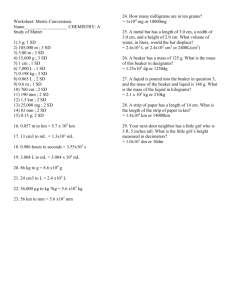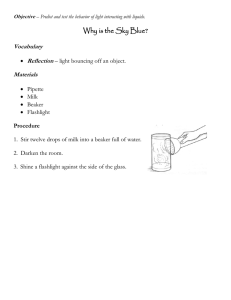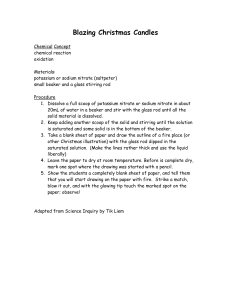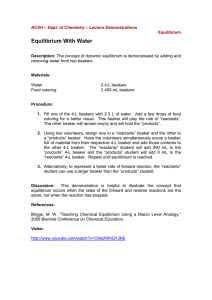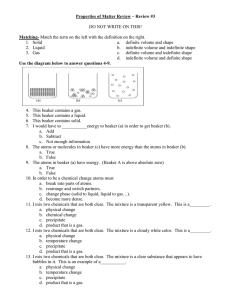Chemistry Unit Test Study Guide
advertisement
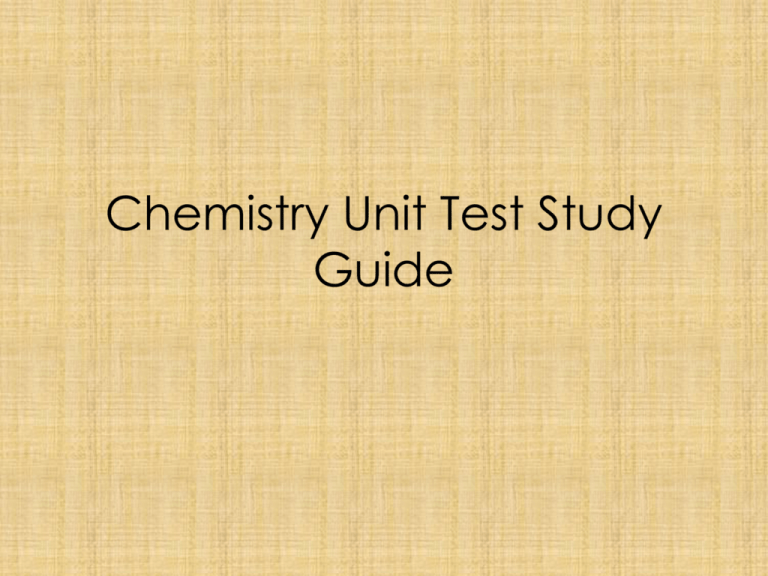
Chemistry Unit Test Study Guide 1. The basic unit of matter is: – An atom 2. List three things that are not made up of matter and do not have mass: • light • sound • Heat 3. What is the difference between a chemical change and a physical change? – A chemical change is when one substance changes into another substance. The atoms have been re-arranged, and you can only change it back if you break the chemical bonds. Physical changes can be easily changed back to the original. 4. Give one example of a chemical change. – cooking an egg 5. Give one example of a physical change. – cutting paper, melting an aluminum can 6. During the chemical reaction of baking soda and vinegar, bubbles appear. What’s in the bubbles? – carbon dioxide 7. What is a reactant? – a substance that is present at the beginning of a chemical reaction and is changed into a new substance. 8. What is a product? – A substance formed by a chemical reaction. 9. In a chemical reaction, what are the similarities between reactants and products? - the mass of the products and reactants are the same – the atoms have just been re-arranged. 10. Balance the following equation: CH4 + O2 CH4 + 2O2 --------- --------- CO2 + H 2O CO2 + 2 H2O Fe2O3 is the chemical formula for iron oxide (rust). Answer the following questions using this formula. 11. How many different elements are used to make iron oxide? – 2 (Fe and O) 12. How many atoms are needed to make iron oxide? – 5 (2 Fe and 3 O) 13. How many molecules are represented by this formula? – 1 14. What does the Law of Conservation of Matter say? – Particles cannot be created or destroyed, only rearranged. 15. What happened when we put steel wool into a flask and put a balloon over it? - the balloon was sucked into the flask. 16. What happens to the weight of a glass of cold lemonade when all of the ice melts? - the weight stays the same. 17. What are the chemical symbols for the following elements? – – – – – Hydrogen - H Oxygen - O Iron - Fe Sodium - Na Copper - Cu You observe two beakers of water that each have 100 ml of water in them. One contains very hot water and the other contains very cold water. 18. Which beaker has the greater mass? Why? - The beaker with the cold water has the greater mass because the molecules in a cold liquid are closer together, therefore more can fit in the beaker. 19. Which beaker has the greater volume, or are they the same? Why? - Both beakers have the same volume, 100 ml 20. Which beaker has the greater density? Why? - The cold beaker has the a greater density because it has more mass. 21. The Periodic table consists of 18 columns called ___groups___ and 7 rows called ___periods____. 22. Protons have a __positive___ charge. Neutrons have a __neutral____ charge. Electrons have a ___negative__ charge. 23.Most of the elements on the periodic table are: – Metals 24. This group of elements got its name because it almost never reacts with other elements: – Noble Gases 25. How do you calculate volume? – Volume = length * width * height 26. How do you calculate density? – Density = mass / volume 27. A glass marble has a volume of 5 cm3 and a mass of 13 g. What is the density of the glass? – Density of the glass = 13 g / 5 cm3 – Density of the glass = 2.6 g/ cm3
